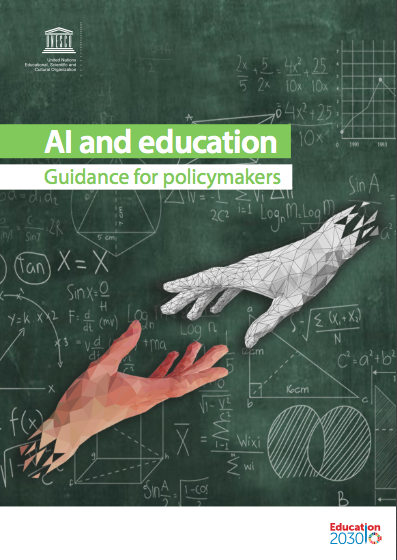 UNESCO have recently published a document on AI and Education aimed as guidance for policy makers. This report discusses the promise of the benefits of AI, which are of course inextricable from AI’s implications and risks.
UNESCO have recently published a document on AI and Education aimed as guidance for policy makers. This report discusses the promise of the benefits of AI, which are of course inextricable from AI’s implications and risks.
So, first of all, what are the benefits that AI promises according to UNESCO?
To begin with, AI technologies are increasingly being used to facilitate the management and delivery of education. Rather than supporting teaching or learning directly, these system-facing applications are designed to automate aspects of school administration, including admissions, timetabling, attendance and homework monitoring, and school inspections.
However, it is the use of AI technologies that are mostly student-facing that have received the most attention from researchers, developers, educators and policy-makers. To the point of being considered the ‘Fourth Education Revolution’ (Seldon and Abidoye, 2018). The main aim is to provide every learner, wherever they are in the world, with access to high-quality, personalized, and ubiquitous lifelong learning.
Lastly, despite its potential to empower teachers, the use of teacher-facing AI applications to enhance teaching has to date received far less attention than student-facing AI, which by definition replaces the teacher. Many teacher-facing AI applications aim to help teachers reduce workloads by automating tasks such as assessment, plagiarism detection. It is likely that the teacher's role will change once this technology is widely used, and teachers will need to build new competencies.
In short, AI is leading us ever closer to the fourth sustainable development goal (SDG 4), established by the United Nations in 2015, which aims to insure inclusive and equitable quality education and promote lifelong learning opportunities for all. Despite the potential of AI within education, there are many obstacles that society must surmount to unleash the potential of AI whilst mitigating its downsides, to build the future-proof education systems of SDG 4.
Amongst them, AI’s impact on students, teachers and wider society is yet to be determined. This includes questions about the efficacy of AI interventions, the choice of pedagogies used in AI tools, students’ privacy, teachers’ jobs, and what we should be teaching at schools and universities.
Another issue is related to data and algorithms, which are at the heart of contemporary AI. This raises challenges centred on data protection, privacy, and ownership, and on data analysis. Additionally, although AI itself is not biased, the data and algorithms can be, and the original and perhaps unidentified biases can become more noticeable and have a greater impact.
There is also a common concern, that of teachers being made redundant. Despite the commercial aims of using intelligent tutorial systems to do teacher tasks, it is still unlikely that teachers will be replaced by machines any time soon. The aim is to relieve teachers of certain tasks so that they may focus on the human aspect of teaching. It is however important to take into consideration exactly how the teacher’s role will be reformed.
In a similar vein, even though teachers would not be fully replaced, learners’ agency might be undermined by more use of adaptive AI in education. This is to say less time for learners to interact with each other, more decisions made by machines, and more focus on the type of knowledge that is easiest to automate. This could deprive learners from developing many essential skills such as resourcefulness, self-efficacy, self-regulation, metacognition, critical thinking, independent thought, etc. In addition, the design implements instructionist methods that focus on knowledge transfer and content delivery while ignoring contextual and social factors.
The full publication can be accessed here.
